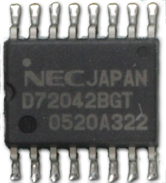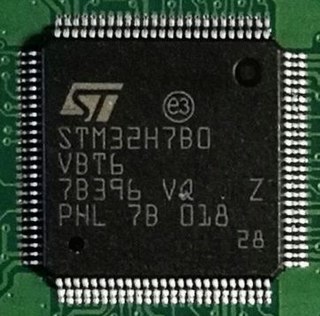Related Research Articles

A microcontroller or microcontroller unit (MCU) is a small computer on a single integrated circuit. A microcontroller contains one or more CPUs along with memory and programmable input/output peripherals. Program memory in the form of ferroelectric RAM, NOR flash or OTP ROM is also often included on chip, as well as a small amount of RAM. Microcontrollers are designed for embedded applications, in contrast to the microprocessors used in personal computers or other general purpose applications consisting of various discrete chips.

The Z80 is an 8-bit microprocessor introduced by Zilog as the startup company's first product. The Z80 was conceived by Federico Faggin in late 1974 and developed by him and his 11 employees starting in early 1975. The first working samples were delivered in March 1976, and it was officially introduced on the market in July 1976. With the revenue from the Z80, the company built its own chip factories and grew to over a thousand employees over the following two years.

The Intel MCS-51 is a single chip microcontroller (MCU) series developed by Intel in 1980 for use in embedded systems. The architect of the Intel MCS-51 instruction set was John H. Wharton. Intel's original versions were popular in the 1980s and early 1990s, and enhanced binary compatible derivatives remain popular today. It is a complex instruction set computer, but also has some of the features of RISC architectures, such as a large register set and register windows, and has separate memory spaces for program instructions and data.

AVR is a family of microcontrollers developed since 1996 by Atmel, acquired by Microchip Technology in 2016. These are modified Harvard architecture 8-bit RISC single-chip microcontrollers. AVR was one of the first microcontroller families to use on-chip flash memory for program storage, as opposed to one-time programmable ROM, EPROM, or EEPROM used by other microcontrollers at the time.
SuperH is a 32-bit reduced instruction set computing (RISC) instruction set architecture (ISA) developed by Hitachi and currently produced by Renesas. It is implemented by microcontrollers and microprocessors for embedded systems.

PIC is a family of microcontrollers made by Microchip Technology, derived from the PIC1650 originally developed by General Instrument's Microelectronics Division. The name PIC initially referred to Peripheral Interface Controller, and is currently expanded as Programmable Intelligent Computer. The first parts of the family were available in 1976; by 2013 the company had shipped more than twelve billion individual parts, used in a wide variety of embedded systems.

The MSP430 is a mixed-signal microcontroller family from Texas Instruments, first introduced on 14 February 1992. Built around a 16-bit CPU, the MSP430 was designed for use with low power consumption embedded applications and for low cost.
Renesas Electronics Corporation is a Japanese semiconductor manufacturer headquartered in Tokyo, Japan, initially incorporated in 2002 as Renesas Technology, the consolidated entity of the semiconductor units of Hitachi and Mitsubishi excluding their dynamic random-access memory (DRAM) businesses, to which NEC Electronics merged in 2010, resulting in a minor change in the corporate name and logo to as it is now.
JTAG is an industry standard for verifying designs and testing printed circuit boards after manufacture.

The Blackfin is a family of 16-/32-bit microprocessors developed, manufactured and marketed by Analog Devices. The processors have built-in, fixed-point digital signal processor (DSP) functionality supplied by 16-bit multiply–accumulates (MACs), accompanied on-chip by a microcontroller. It was designed for a unified low-power processor architecture that can run operating systems while simultaneously handling complex numeric tasks such as real-time H.264 video encoding.
V850 is a 32-bit RISC CPU architecture produced by Renesas Electronics for embedded microcontrollers. It was designed by NEC as a replacement for their earlier NEC V60 family, and was introduced shortly before NEC sold their designs to Renesas in the early 1990s. It has continued to be developed by Renesas as of 2018.

PSoC is a family of microcontroller integrated circuits by Cypress Semiconductor. These chips include a CPU core and mixed-signal arrays of configurable integrated analog and digital peripherals.

IEBus is a communication bus specification "between equipments within a vehicle or a chassis" of Renesas Electronics. It defines OSI model layer 1 and layer 2 specification. IEBus is mainly used for car audio and car navigations, which established de facto standard in Japan, though SAE J1850 is major in United States.
IEBus is also used in some vending machines, which major customer is Fuji Electric. Each button on the vending machine has an IEBus ID, i.e. has a controller.
Detailed specification is disclosed to licensees only, but protocol analyzers are provided from some test equipment vendors. Its modulation method is PWM with 6.00 MHz base clock originally, but most of automotive customers use 6.291 MHz, and physical layer is a pair of differential signalling harness. Its physical layer adopts half-duplex, asynchronous, and multi-master communication with carrier-sense multiple access with collision detection (CSMA/CD) for medium access control. It allows for up to fifty units on one bus over a maximum length of 150 meters. Two differential signalling lines are used with Bus+ / Bus− naming, sometimes labeled as Data(+) / Data(−).
TLCS is a prefix applied to microcontrollers made by Toshiba. The product line includes multiple families of CISC and RISC architectures. Individual components generally have a part number beginning with "TMP". E.g. the TMP8048AP is a member of the TLCS-48 family.
The Mitsubishi 740, also known as MELPS 740, is a series of 8-bit CMOS microcontrollers and microprocessors with an enhanced MOS Technology 6502 compatible core based on the expanded WDC 65C02. The ICs were manufactured by Mitsubishi Electric during the 1980s and 1990s.

The Infineon XC800 family is an 8-bit microcontroller family, first introduced in 2005, with a dual cycle optimized 8051 "E-Warp" core. The XC800 family is divided into two categories, the A-Family for Automotive and the I-Family for Industrial and multi-market applications.

STM32 is a family of 32-bit microcontroller integrated circuits by STMicroelectronics. The STM32 chips are grouped into related series that are based around the same 32-bit ARM processor core: Cortex-M0, Cortex-M0+, Cortex-M3, Cortex-M4, Cortex-M7, Cortex-M33. Internally, each microcontroller consists of ARM processor core(s), flash memory, static RAM, debugging interface, and various peripherals.

LPC is a family of 32-bit microcontroller integrated circuits by NXP Semiconductors. The LPC chips are grouped into related series that are based around the same 32-bit ARM processor core, such as the Cortex-M4F, Cortex-M3, Cortex-M0+, or Cortex-M0. Internally, each microcontroller consists of the processor core, static RAM memory, flash memory, debugging interface, and various peripherals. The earliest LPC series were based on the Intel 8-bit 80C51 core. As of February 2011, NXP had shipped over one billion ARM processor-based chips.

78K is the trademark name of 16- and 8-bit microcontroller family manufactured by Renesas Electronics, originally developed by NEC started in 1986. The basis of 78K Family is an accumulator-based register-bank CISC architecture. 78K is a single-chip microcontroller, which usually integrates; program ROM, data RAM, serial interfaces, timers, I/O ports, an A/D converter, an interrupt controller, and a CPU core, on one die.
References
- 1 2 3 4 "Renesas Electronics Introduces the New RL78 Microcontroller Family to Deliver Solutions for Next-Generation 8-/16-bit Embedded Applications". Business Wire (Press release). Renesas Electronics. 2010-11-17.
- ↑ Matsui, Mitsuru; Murakami, Yumiko (11 March 2013). "Minimalism of Software Implementation: Extensive Performance Analysis of Symmetric Primitives on the RL78 Microcontroller" (PDF). Fast Software Encryption. 20th International Workshop, FSE 2013. Lecture Notes in Computer Science. Vol. 8424. Singapore. pp. 393–409. doi:10.1007/978-3-662-43933-3_20. ISBN 978-3-662-43933-3.
- ↑ Dean, Alexander G.; Conrad, James M. (2012). Creating Fast, Responsive and Energy-Efficient Embedded Systems using the Renesas RL78 Microcontroller (PDF). 1290 Weston Road, Suite 306 Weston, FL 33326 USA: Micrium Press. ISBN 9781935772989.
{{cite book}}: CS1 maint: location (link) - ↑ "78K0R Microcontrollers User's Manual: Instructions". p. 14. Retrieved 2023-11-29.
- ↑ Renesas official: RL78 family User's Manual: Software. Renesas Electronics.
- ↑ Renesas official: 78K0R Microcontrollers User's Manual: Instructions. Renesas Electronics.
- ↑ Renesas official: 78K/0S Series for Instructions. Renesas Electronics.
- ↑ Renesas official: 78K/0 Series for Instructions. Renesas Electronics.
- ↑ Renesas official: Renesas Microcontrollers RL78 Family. Renesas Electronics.
- 1 2 SHASHI KIRAN K (16 April 2017). "Renesas RL78 Series Microcontroller Programming Steps". YouTube.
- ↑ Hemachandra, S.; Kiran, T.K.S. Ravi; Prasad, B. Gowri; Mazhar, S. M. (April 2014). "Accelerometer based Robot control using Renesas Microcontroller" (PDF). International Journal of Modern Engineering Research: 40–48.
- ↑ Renesas official: RL78/F15 User's Manual: Hardware. Renesas Electronics.
- ↑ Renesas official: Renesas Automotive: RL78 Brushless DC Motor Solution. Renesas Electronics.
- ↑ Renesas official: RL78/F13, F14 User's Manual: Hardware. Renesas Electronics.
- ↑ "Using the GNU Compiler Collection (GCC): RL78 Options". gcc.gnu.org.
- ↑ "CS+ (formerly CubeSuite+)". Renesas Electronics.
- ↑ "e² studio". Renesas Electronics.
- ↑ Emilio, Maurizio Di Paolo (2014). Embedded Systems Design for High-Speed Data Acquisition and Control. Springer. ISBN 9783319068657.
- 1 2 3 "Renesas Electronics America Expands the Ecosystem For Its RL78 Microcontroller Family". Business Wire. 2011-05-02.
- ↑ "AP4, Applilet". Renesas Electronics.
- ↑ "Code Flash Libraries (Flash Self Programming Libraries)". Renesas Electronics.
- ↑ "Data Flash Libraries". Renesas Electronics.
- ↑ "On-chip Debuggers". Renesas Electronics.
- ↑ "On-Chip Analyzers (Debug & Trace) - iSYSTEM - Enabling Safer Embedded Systems". www.isystem.com.
- ↑ "IECUBE for RL78 family". Renesas Electronics.
- ↑ "Target Adaptation - iSYSTEM - Enabling Safer Embedded Systems". www.isystem.com.
- ↑ "Renesas Flash Programmer (Programming GUI)". Renesas Electronics.
- ↑ "PG-FP5". Renesas Electronics.
- ↑ "PG-FP6". Renesas Electronics.
- ↑ Renesas official: RL78 Microcontroller Brochure. Renesas Electronics.
- ↑ "The Renesas RL78 for Low-Power Applications | Circuit Cellar". Circuit Cellar. 2012-04-09.
- ↑ Donovan, John (2013-01-16). "Hands-on Review of the Renesas RL78G13 Kit | DigiKey". www.digikey.jp. Digi-Key Electronics.
- ↑ "Renesas Electronics Announces New RL78 Microcontrollers with Enhanced Real-Time Control Capabilities". Business Wire. 2011-06-23.